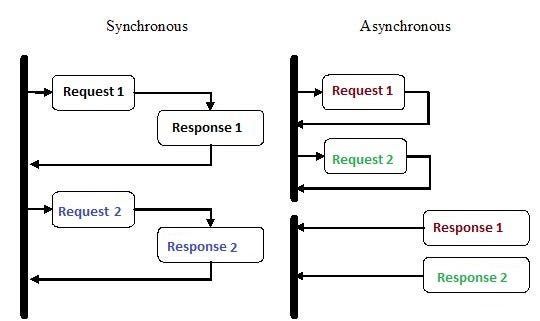Asynchronous programming is a crucial concept in modern software development, particularly for applications that require a high degree of performance, scalability, and responsiveness. It enables software to perform multiple operations without waiting for previous tasks to complete, allowing applications to handle tasks concurrently. This approach is essential for applications that rely on external resources, like fetching data from a server, reading files, or waiting for user input.
1. What is Asynchronous Programming?
Asynchronous programming is a form of programming where tasks are executed independently of the main program flow. Unlike synchronous programming, where tasks are executed one after the other, asynchronous programming allows certain operations to be executed in the background without blocking the execution of other tasks.
For example, in a synchronous program, if a task takes too long (e.g., making a network request), the entire program would pause and wait for that task to complete. In asynchronous programming, the program can continue running other tasks while waiting for the resource-intensive task to finish.
2. Why Asynchronous Programming is Important
A. Improved Performance
One of the primary reasons to use asynchronous programming is the performance benefits it offers. Asynchronous operations allow applications to make better use of system resources by not waiting for slow tasks to complete before starting new ones.
B. Better User Experience
Asynchronous programming enhances the user experience by making applications more responsive. For example, in web applications, tasks like loading images, fetching data from servers, or waiting for user actions can be handled asynchronously. This ensures that the user interface remains interactive, even when tasks are being processed in the background.
C. Scalability
Asynchronous programming is essential for scalable software systems. It allows applications to handle a higher volume of tasks simultaneously, making it easier to scale up without drastically increasing resource consumption.
3. Asynchronous Programming Techniques
A. Callbacks
A callback is a function that is passed into another function as an argument and is executed after the completion of the asynchronous task. While callbacks are a fundamental concept in asynchronous programming, they can sometimes lead to “callback hell” if not managed properly.
function fetchData(callback) {
setTimeout(() => {
console.log("Data fetched!");
callback();
}, 1000);
}
fetchData(() => {
console.log("Processing data...");
});B. Promises
Promises provide a cleaner, more readable way to handle asynchronous code than callbacks. A promise represents an eventual completion or failure of an asynchronous operation, allowing developers to handle success or failure cases easily.
const fetchData = new Promise((resolve, reject) => {
setTimeout(() => {
resolve("Data fetched!");
}, 1000);
});
fetchData
.then((data) => console.log(data))
.catch((error) => console.log(error));C. Async/Await
async/await is a modern syntax introduced in JavaScript that builds on top of promises and offers a simpler, more readable way to work with asynchronous code. Using async/await, developers can write asynchronous code that looks synchronous, making it easier to debug and maintain.
async function fetchData() {
try {
const data = await fetch("https://api.example.com/data");
console.log(data);
} catch (error) {
console.log(error);
}
}
fetchData();D. Event Loop
The event loop is an essential component of asynchronous programming, especially in JavaScript. It ensures that non-blocking operations (like I/O tasks) can be executed while still allowing the main thread to handle other tasks. When an asynchronous task completes, the event loop ensures the result is processed by the main thread.
4. Asynchronous Programming in Different Languages
A. JavaScript
JavaScript is well-known for its event-driven, non-blocking nature. Using callbacks, promises, and async/await, JavaScript handles asynchronous operations efficiently in web development, especially in Node.js and client-side web applications.
B. Python
Python supports asynchronous programming through its asyncio library. With the use of async and await keywords, Python developers can easily write non-blocking code to improve performance in applications like web servers or data processing.
import asyncio
async def fetch_data():
await asyncio.sleep(1)
print("Data fetched!")
asyncio.run(fetch_data())C. C#
In C#, the Task-based Asynchronous Pattern (TAP) is used for asynchronous programming. Developers can write asynchronous code using the async and await keywords, similar to JavaScript and Python.
public async Task<string> FetchDataAsync() {
await Task.Delay(1000);
return "Data fetched!";
}D. Java
Java has introduced asynchronous programming concepts through its CompletableFuture class, allowing developers to handle asynchronous tasks in a more flexible and readable way.
5. Challenges of Asynchronous Programming
A. Complexity
Asynchronous programming can add complexity to code, making it harder to read, understand, and debug. Developers need to be cautious about managing the flow of their program and handling exceptions effectively.
B. Concurrency Issues
When multiple asynchronous operations interact with shared resources (like memory or databases), concurrency issues like race conditions can arise. Proper synchronization mechanisms must be used to avoid conflicts.
C. Callback Hell
Using callbacks in asynchronous programming can lead to deeply nested code, commonly known as “callback hell.” Promises and async/await provide better ways to manage asynchronous tasks and avoid this issue.
6. Conclusion
Asynchronous programming is a powerful tool in software development, enabling developers to build highly responsive, scalable, and efficient applications. By allowing multiple tasks to be processed concurrently without blocking the main program, asynchronous techniques are essential for handling real-time data, network requests, user input, and other time-consuming operations.
At TechsterTech.com, we specialize in building high-performance, scalable software solutions using modern asynchronous programming techniques. Whether you’re developing a web application, a mobile app, or a backend service, our team can help you leverage asynchronous programming for better user experiences and system performance.



